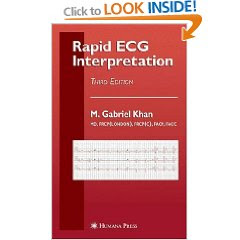1. Basic Concepts
- Electrical Activity of the Heart
- Electrocardiogram
- How Are the Waves of the Electrocardiogram Produced?
- Why Use 12 Leads to Record the
- Electrocardiogram? Leads and Electrodes
- Genesis of the QRS Complex
- Vector Forces
- QRS Normal Variants and Abnormalities
2. Step-by-Step Method for Accurate Electrocardiogram Interpretation
- The Normal Electrocardiogram
- Assess Rhythm and Rate
- Assess Intervals and Blocks
- Assess for Nonspecific
- Intraventricular Conduction Delay and Wolff-Parkinson-White Syndrome
- Assess for ST Segment Elevation or Depression
- Assess for Pathologic Q Waves (That is, Loss of R Waves)
- Assess P Waves
- Assess for Left and Right Ventricular Hypertrophy
- Assess T Waves
- Assess Electrical Axis
- Assess for Miscellaneous Conditions
- Assess Arrhythmias
- Electrocardiogram Technique
3. P Wave Abnormalities
- Features of the Normal P Wave
- Features of Abnormal P Waves
4. Bundle Branch Block
- Right Bundle Branch Block (RBBB)
- Left Bundle Branch Block (LBBB)
5. ST Segment Abnormalities
- Why Emphasize the St Segment?
- ST Elevation Myocardial Infarction
- Non–ST Segment Elevation MI
- Ischemia
- Nonspecific ST Change
6. Q Wave Abnormalities
- Criteria for Normal and Abnormal Q Waves
- Q Wave Myocardial Infarction
- Mimics of Q Wave Myocardial Infarction
- Left Bundle Branch Block and Infarction
- Right Bundle Branch Block and Infarction
- Low-Voltage QRS
7. Atrial and Ventricular Hypertrophy
- Atrial Hypertrophy
- Ventricular Hypertrophy
8. T Wave Abnormalities
- Normal Direction of T Wave
- Abnormalities of T Wave
- U Waves
- Electrical Axis
- Fascicular Block
10. Miscellaneous Conditions
- Atrial Septal Defect
- Pericarditis
- Long Qt Interval
- Hypokalemia
- Hyperkalemia
- Digitalis
- Dextrocardia: True Dextrocardia (with Situs Inversus)
- Electrical Alternans
- Electronic Pacing
- Pulmonary Embolism
- Hypothermia
- Hypercalcemia
- Hypocalcemia
11. Arrhythmias
- Atrial Premature Beats
- Junctional or Nodal Premature Beats
- Ventricular Premature Beats
- Bradyarrhythmias
- Narrow QRS Tachycardias
- Wide QRS Tachycardia
- Regular Wide QRS Tachycardia
12. ECG Board Self-Assessment Quiz
- ECG Board Self-Assessment Quiz
- Answers to ECG Board Self-Assessment Quiz
.




0 comments:
Post a Comment